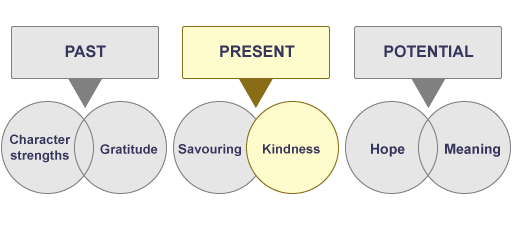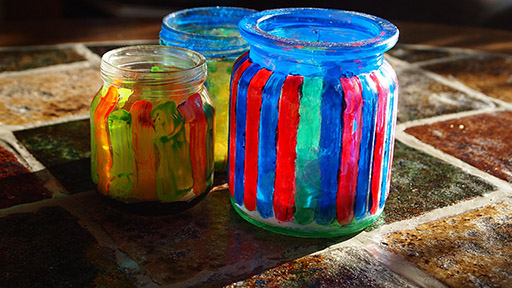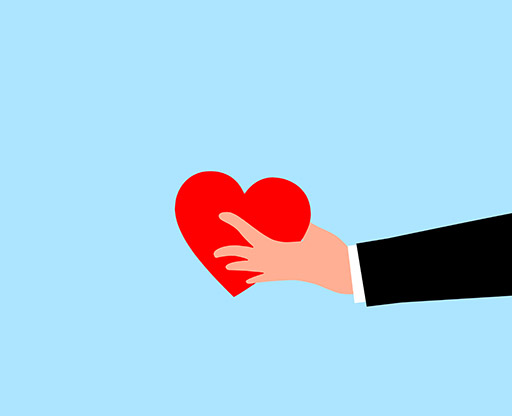Use 'Print preview' to check the number of pages and printer settings.
Print functionality varies between browsers.
Printable page generated Saturday, 22 November 2025, 3:13 PM
Unit 5: Kindness
The fourth of six themes
Throughout this course you are introduced to some of the ways you can boost your happiness and wellbeing, and that of your children, using six key themes that have been shown to improve wellbeing through the way we think about the past, present and future potential.
The fourth of these six themes is illustrated in the diagram below.
For this fourth theme, you are shown some practical activities that you can try at home. The benefits of these have all been supported scientifically and can be attempted by yourself during the course. They can also be adapted to work with children of all ages within the home. Being a good role model to our children is also a great way to help enhance their wellbeing.
 Mindful minute
Mindful minute
To start each unit, it is helpful to try to switch off from what has been happening in your day and greet your learning from a place of relaxation. The following exercise can be a way of doing this, so please feel free to try this. Alternatively, you may have your own way of switching off from the distractions of your day, like making a hot drink or putting on some calming music.
Sit in a comfortable position with your hands resting on your lap. Try to keep your back, neck and head straight and place both of your feet flat on the floor.
Bring your attention to your breath and consciously try to relax your shoulders. Imagine that the muscles in your shoulders are melting into your body and breathe deeply into your belly so that you can feel it expanding.
Press the button below which will set a timer for 1 minute. Close your eyes and continue to focus on your breathing and relaxing your shoulders. It is normal for your mind to wonder, and when this happens try to gently bring it back to your breathing and relaxing.
After a minute you will hear a buzzer. Open your eyes and continue with the course.
5.1. What is kindness and how can it help you and your family?
Giving and receiving kindness has always been highly regarded through many spiritual, religious and ethical traditions throughout history.
 How kindness can protect against the negative effects of stress
How kindness can protect against the negative effects of stress
In this video Michelle explains how kindness towards yourself, as well as to others, can be beneficial in helping you and your family to protect yourself against the negative effects of stress.
This is of particular relevance when dealing with times of adversity, like the pandemic.

Transcript
In simple terms, kindness is a type of behaviour defined by generosity, consideration or concern for others. Kindness can be manifested in diverse ways by individuals and can be an outward expression of love and grace. When considering the character strengths from Unit 2, love and kindness, along with social intelligence, are considered to be key strengths of humanity. As kindness is considered to be a part of being human, positive psychologists are interested in increasing the opportunities in your life to practise it.
During the COVID-19 pandemic there were many examples of kindness shown in communities. A great example of this in the UK was Captain Sir Thomas Moore, who decided to walk around his garden every day, doing 100 laps by the time he turned 100 on 30th April 2020, to raise £1000 for NHS Charities Together. The public were so moved by his efforts that they were inspired to respond with kindness and donate to his fundraising, and he raised over £32,000,000!
 Kindness
Kindness
5.2 Benefits of kindness
Practising kindness has been shown through studies to have some benefits that are universally positive, but particularly interesting to consider in the family context.
When practising acts of kindness, it is often done without the expectation of personal gain.
However, there can be benefits for both parties. The people carrying out the acts of kindness can also experience positive feelings of joy, connection and can redirect attention away from themselves. Our brains’ reward systems experience a burst of happy hormones, such as oxytocin, when carrying out kind acts.
Studies have also shown that when people carry out five acts of kindness a day, they report feeling happier for many days afterwards (Lyubomirsky, 2007, pp.127–9). This research shows that the more acts of kindness carried out within a short period, the higher the positive effect.
 Spreading kindness
Spreading kindness
Enjoy the short films below about spreading kindness.
5.3 How to use kindness with your family to enhance wellbeing
Here are a series of activities you could do with your family, your friends and your local community.
 Have a random act of kindness day
Have a random act of kindness day
Choose a day with your family and decide to each carry out as many random acts of kindness as possible in the home. These can be as small or large as you want. Each family member can choose appropriate activities depending on age, e.g., smile at a family member, tidy up without being asked etc.
At the end of the day, come together and share your acts of kindness with each other. Consider having prizes for the most carried out, most thoughtful, etc.
 Bring kindness to your community
Bring kindness to your community
This activity is similar to the random acts of kindness day, but this time carry out your acts in your wider community. Think of how you can be kind to a friend or say hello to a neighbour that you normally just pass by.
You may want to volunteer your time to a needy cause or give some money to a charity. Perhaps you could offer to walk a dog for someone who looks like they have a busy life or cook an extra portion of food for an elderly neighbour.
Be aware that this is a special day where you are being kinder than usual, so try not to choose acts that might feel overwhelming or that you don’t have the time or energy to carry out. Do what you can and afterwards consider how it made you feel.
 Make a kindness jar
Make a kindness jar
A fun activity for younger children is to create a kindness jar. Each time you notice that your child does something kind, write it down on a scrap of paper, fold it up and put it in a recycled jar (another example of kindness for the planet). If you have any loose change, you can add this to the jar as well. Keep adding to the jar until it is full.
Have an emptying ceremony and read out and reminisce together about the kind things that your child did. Allow them to keep the loose change as a reward for all the kindness they have carried out.
 Watch films together with themes of love and kindness
Watch films together with themes of love and kindness
Choose a film with strong themes of kindness and love to watch with your family. When the film has finished talk together about where you saw kindness in the film and how it made you feel.
Wonder (2017) |
The BFG (2016) |
Finding Dory (2016) |
Paddington (2015) |
Shrek (2001) |
E.T. (1982) |
 Celebrate somebody else’s success
Celebrate somebody else’s success
Make a conscious effort to celebrate when things go well for your family members and friends.
Ask them to discuss how they are feeling and how the experience has been for them and express your pride over their success.
This can be challenging at times, so try to be authentic in your response. By learning to respond to their good news in an excited way, it is possible to improve the wellbeing of your relationships.
 Be kind to yourself
Be kind to yourself
This can be a particularly challenging area for many people, especially if raising a family, when you may feel that your needs come at the bottom of a very long list. Self-compassion means to just look at yourself and all your perfectly normal imperfections with kindness.
Try to find some activities that you enjoy doing that offer you to the chance to care for yourself. Perhaps try a free mediation class online, have a nourishing meal, prioritise sleep and take time for some gentle exercise.
You might want to consider writing a kind letter to yourself when you are feeling in a positive frame of mind, that you can refer back to when you are feeling low and remind yourself that you deserve kindness as much as anyone else.
5.4 Summary
In this unit you have examined the character strength of kindness and its many benefits.
In the next unit you explore hope and optimism, as you look at how positive psychology can be used to help you to fulfil your potential.
 Further resources
Further resources
Altruism: The Science and Psychology of Kindness Paperback – 4 Jan. 2018 by Matthieu Ricard. |
Kindness: Change your life and make the world a kinder place by Gill Hasson. |
Kindness: The Little Thing that Matters Most by Jamie Thurston. |
Kindness is my Superpower: A children's Book About Empathy, Kindness and Compassion (My Superpower Books) by Alicia Ortego. |
Now go to Unit 6: Hope and optimism, where you explore the fifth of our six principles.
References
Arnocky, S., Piché, T., Albert, G., Ouellette, D. & Barclay, P. (2017) 'Altruism predicts mating success in humans', British Journal of Psychology, 108(2), pp.416-435.
Eisenberg, N. & Fabes, R.A., (1990) 'Empathy: Conceptualization, measurement, and relation to prosocial behavior', Motivation and Emotion, 14(2), pp.131-149.
Fowler, J.H. & Christakis, N.A. (2010) 'Cooperative behavior cascades in human social networks', Proceedings of the National Academy of Sciences, 107(12), pp.5334-5338.
Otake, K., Shimai, S., Tanaka-Matsumi, J., Otsui, K. & Fredrickson, B.L. (2006) 'Happy people become happier through kindness: A counting kindnesses intervention', Journal of Happiness Studies, 7(3), pp.361-375.
Poulin, M.J. & Holman, E.A. (2013) 'Helping hands, healthy body? Oxytocin receptor gene and prosocial behavior interact to buffer the association between stress and physical health', Hormones and Behavior, 63(3), pp.510-517.
Raposa, E.B., Laws, H.B. & Ansell, E.B. (2016) 'Prosocial behavior mitigates the negative effects of stress in everyday life', Clinical Psychological Science, 4(4), pp.691-698.Trew, J.L. & Alden, L.E. (2015) 'Kindness reduces avoidance goals in socially anxious individuals', Motivation and Emotion, 39(6), pp.892-907.
Waters, E., Wippman, J. & Sroufe, L.A. (1979) 'Attachment, positive affect, and competence in the peer group: Two studies in construct validation', Child Development, pp.821-829.
Woods, S., Lambert, N., Brown, P., Fincham, F. & May, R. (2015) ‘“I’m so excited for you!” How an enthusiastic responding intervention enhances close relationships’, Journal of Social and Personal Relationships, 32(1), pp. 24–40. doi:10.1177/0265407514523545.






